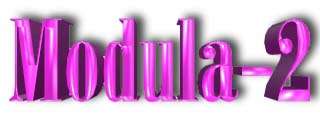
Modula-2 Programming Language
Click below to go directly to a specific section:
History |
Significant Language Features |
Areas of Application |
Sample Programs
Related Links |
Printed References |
Acknowledgements
History
In the mid 1970's, after the language Pascal was designed,
Niklaus Wirth was experimenting with concurrency which led to the
design of Modula. Modula was never released and its development was
discontinued after its publication. Wirth then built a language that
was meant to be the single language for the new computer system
called Lilith. Even though the computer was never a success, his new
language Modula-2 was released in 1980.
Significant Language Features
Modula-2 was designed based on Pascal and Modula but its improvements
over Pascal included modules, low level features, coroutines, and
syntactic features.
- Modules - a tool for expressing the
relations between major parts of programs and provide
support for abstract data types.
- Low Level Features - small language which
can be implemented on a wide variety of microcomputers.
contains facilities for high level and low level programming.
- Coroutines - used for embedded systems that
require concurrency without the overhead of large operating systems
or large languages.
- Syntactic Features - has a small
vocabulary and consists of few sentence structures.
contains simple and consistant rules of syntax which makes
it easy to learn.
Areas of Application
Modula-2 is a simple but yet a powerful language that is suitable
for a wide range of applications.
- Systems Programming
- Concurrent Programming
- Embedded Systems
- Software Engineering
- Education
Modula-2 Programs
Related Links
Printed References
- Christian, Kaare (1986). A Guide To Modula-2.
Springer-Verlag, New York.
- McKay, Kenneth and Moore, John (1987).
Modula-2 Text and Reference.
Prentice-Hall, New Jersey.
- Sebesta, Robert (1996). Concepts of Programming Languages
. Addison-Wesley Publishing, CA.
Acknowledgements
I would like to thank Kaare Christian, author of A Guide to
Modula-2, for helping write the sum and average and factorial
program. I would also like to thank John Moore and Kenneth
McKay, authors of Modula-2 Text and Reference, for helping
write the hello world and sum and average program. Robert Sebesta,
author of Concepts of Programming Languages was also
helpful in providing information on the history of Modula-2.

![[Home]](../home_btn.gif)
![[Next]](../next_btn.gif)
Last modified: 01:17 PM on 11/24/1996
This page has been accessed



![[Home]](../home_btn.gif)
![[Next]](../next_btn.gif)